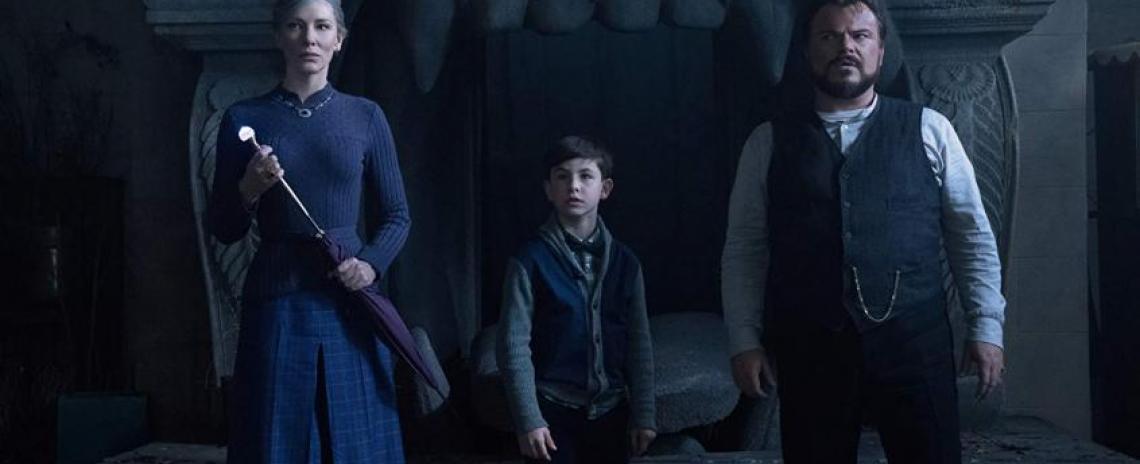Eli Roth’s directing credit follows soon after Steven Spielberg's Amblin Studio logo, and it comes as the first surprise of the YA horror-novel adaptation The House with a Clock in Its Walls. The director’s debut feature, Cabin Fever (2002), is one of the goriest works of the new millennium, rendering leg-shaving a traumatic ordeal for viewers, much as Psycho (1960) did for shower-taking. He followed up his first film with the torture-porn “classics” Hostel (2005) and Hostel: Part II (2007) and hasn’t relented on the blood-letting since, including remaking the revenge saga Death Wish earlier this year. What horrors would Roth now present to House’s theoretical audience of children and families?
Always capable behind the camera, Roth makes films that are rarely dull but also rarely politically or thematically cogent. Cabin Fever hinted at a parable about the AIDS crisis that began in the 1980s. The filmmaker used one of that decade’s favorite horror tropes – sexually active young people meeting their ends deep in the woods – as a jumping-off point to explore mass hysteria and the increasing divide between the urban and rural United States. As with the Hostel films and the W. Bush-era American exceptionalism and jingoism that Roth attempted to satirize with those features, Cabin Fever ultimately falls short in producing any interesting ideas with respect to its real-world parallels.
Accordingly, in adapting John Bellairs’ book of the same name, one would be rightfully leery about what Roth and screenwriter Eric Kripke might smuggle into this family frightfest. Whether inherent in its source or not, The House with a Clock in Its Walls has coherent and surprisingly heartfelt ideas about trauma, loss, and the ways that human communities process such experiences. It achieves this while also being a mostly delightful, minor-sized gothic mystery complete with seed-spewing possessed pumpkins, a topiary lion with a case of leaf-induced irritable bowel syndrome, and Cate Blanchett and Jack Black as an unlikely pair of platonic partners.
As Lewis Barnavelt, young actor Owen Vaccaro gets an opportunity to be a film’s focal point and exhibit a wide range of emotions after playing one of the Daddy’s Home (2016) children opposite Will Ferrell and Mark Wahlberg. Lewis oscillates between grief and wonder as the newly orphaned nerd moves into the ornately spooky mansion his tightly wound uncle, Jonathan Barnavelt (Jack Black), inherited from an old magic partner, Isaac Izard (Kyle MacLachlan). After noticing the stained-glass windows moving and his uncle ax-chopping at the walls (with a fun visual nod to The Shining [1980]) in search of some mysterious ticking, Lewis forces Jonathan and his stately yet somehow still-bumbling next-door neighbor Florence Zimmerman (Cate Blanchett) to come out as magic-makers
Under the tutelage of Florence and Jonathan, Lewis begins to cast his own spells with only minor misfires. The filmmakers mostly avoid the puberty allegory – a la Spider-man learning to shoot webs – instead using the magic as a way for the young warlock (“boy witch,” as Lewis keeps telling his uncle as if to puncture through fragile masculinity) to work through his grief and form a new family unit with the elder dark-arts-doers. Being the new kid in town, he has to contend with his share of bullying from schoolmates, but when he attempts to show off his nascent skills to a potential friend, Tarby (Sunny Suljic), he inadvertently awakens Izard, the recently deceased mechanic of the titular timepiece, causing pure hell to break loose.
The post-World War II milieu of the fictional town of New Zebedee, Mich. enriches the film’s already-present ideas of trauma, collective and personal. Indeed, all the characters within this narrative are either sublimating their loss or displacing their shock. Izard created the clock after time spent in wartorn Germany. The mysterious ticking presence is actually a doomsday device, as it turns out, and obliterating the human race entirely is his personal reaction to the horrors witnessed in fighting the Nazis. After losing her family, Florence’s magical purpose is misplaced – often creating havoc for Lewis and Jonathan – but she self-actualizes as she finds new purpose in saving humanity. Jonathan is looking to reverse the wrong-doing his deceased cohort created after the two separated ways. Although he still has a proverbial hole in his heart from their personal and professional split, he gains confidence and rebuilds his spirit as he teaches Lewis.
The heavy-handed material isn’t handled quite as deftly as the cultural critiques in the supreme Paddington films, but House is closer to the light-touch spirit of those film than such dramatic currents might suggest. Blanchett relishes the opportunity to elicit the laughs Ocean’s 8 (2018) didn’t allow. Her screwball abilities are showcased in her character’s magical misfires and in scenes of Jonathan and Florence bickering like a long-married couple who’ve spent way too much time together. Here, Black is more than serviceable, but elsewhere his hammy performance undermines the grandiosity that would credibly provoke the awe and wonder that Vaccaro displays. Black is often one-upped by his relatively inexperienced co-star in terms of comedic delivery.
Roth’s film is in tune with vintage Disney-produced dark fantasies like Watcher in the Woods (1980) and Escape to Witch Mountain (1975), and the director takes the opportunity to induce nightmares in his youngest viewers – just as those films did for their contemporary audiences. Kid-sized jump-scares like a springing cuckoo from a clock abound, and Roth even wrings some dread from set-pieces like a room full of re-animated evil dolls. Largely due to the overstuffed production design Roth is committed to showcasing, his direction overall lacks clock-like precision. To that end, the film’s final act is a mess of poor action directing – experience Roth admittedly lacks. It does, however, give viewers the opportunity to see Blanchett head-butt a pumpkin, and it’s moments like this that make The House with a Clock in Its Walls a worthy entry in the children’s chiller canon.
Rating: B-


